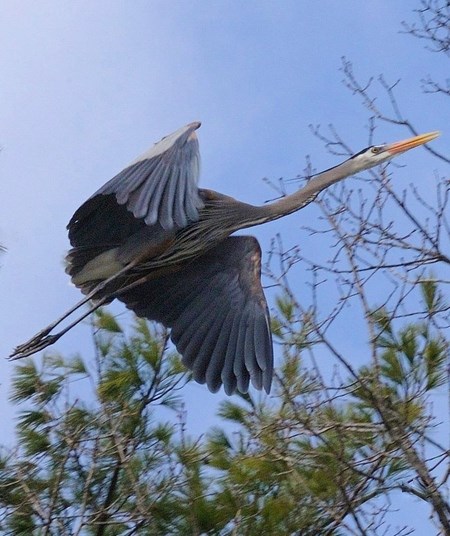
Scott Rando Wading birds, shorebirds, and gulls are a diverse group of birds who inhabit the riparian areas of the Upper Delaware Region. Visitors may see these birds wading in shallow portions of the river or foraging along streambanks. Wading birds possess several distinct physical traits adapted for life near water. Their long, thin legs help keep their feathers dry when wading in deeper water. Long toes help wading birds to stay balanced and keep from sinking into soft mud when foraging. Wading birds like the Great Blue Heron have lengthy muscular necks that they use while hunting prey. Wading birds have a diverse diet and may consume fish, crustaceans, mollusks, and insects, among other prey. Usually their bill is adapted to the prey they consume. For example, egrets have a long spear-like bill which they use to jab fish. Typically, wading birds nest in large colonies along with other birds like gulls and cormorants. Shorebirds usually have round heads, long legs, and bills adapted to probing in mud or water for prey. Their diet is generally carnivorous and may consist of insects, mollusks, crustaceans, worms, larvae, and tadpoles. Shorebirds' plumage is usually white, brown, black, or rust colored, which helps camouflage them from predators. For example, Spotted Sandpipers have a brown back and white underside, which has dark spots during the breeding season. Spotted Sandpipers can be seen foraging along riverbanks. They can be identified by their distinctive walk in which their tails continually bob up and down. Gulls are typically white or gray, although, in breeding season, their heads may be white, gray, or brown. They have a thick bill that is hooked at the end. Except for their hind toes, gulls have fully webbed feet. They tend to be opportunistic feeders, meaning they usually eat whatever they come across. However, their diet consists mostly of insects, mollusks, crustaceans, worms, and fish, among other prey. Gulls are gregarious birds, meaning they often congregate in large groups. They typically create shallow nests on the ground and usually lay one to three eggs. Common wading birds, shorebirds, and gulls in the Upper Delaware Region include: Great Blue Heron (Ardea herodias) Green Heron (Butorides virescens) Killdeer (Charadrius vociferus) |
Last updated: March 10, 2021
